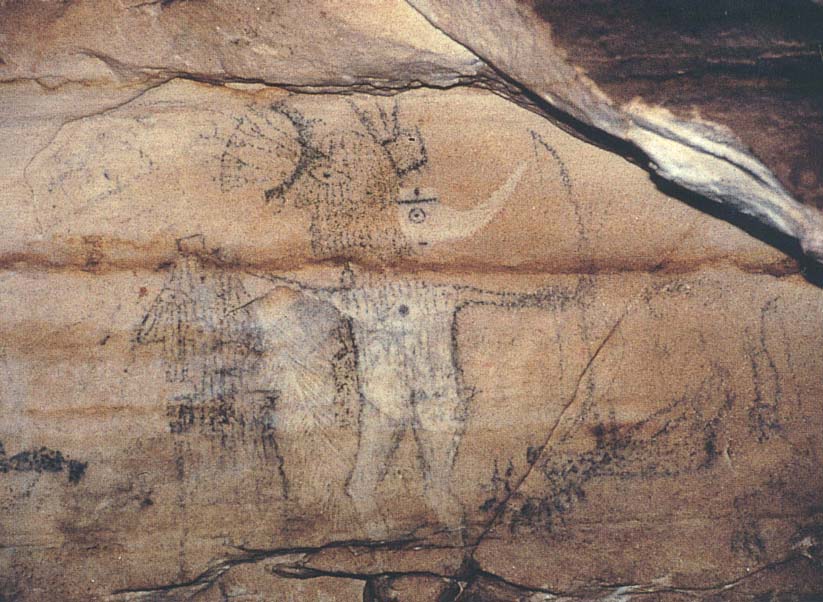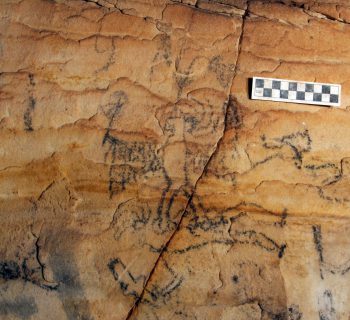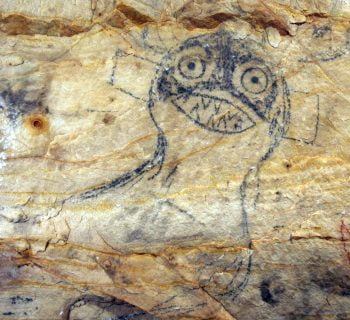Picture Cave: the Mississippian Sistine Chapel

Picture Cave's Morning Star (Red Horn) pictograph.
Picture Cave in Warren County, Missouri is a two-cave system that contains over 290 prehistoric polychrome paintings. Scholars believe the paintings were created by the Mississippian people. The paintings have been dated to approximately 900-1100 CE. Picture Cave is considered to be one of the most important rock art sites in North America, and it is a sacred site for the Osage Nation, who are the descendants of the Mississippian people. Picture Cave is also host to a colony of endangered Indiana bats.
The paintings at Picture Cave depict a variety of subjects, including human figures, animals, plants, and geometric shapes. Some of the paintings are thought to represent religious or spiritual beliefs, while others may have been used for ceremonial purposes. The paintings are also believed to have been used for astronomical observations.
The number, variety, and complexity of images make Picture Cave in Warren County, Missouri one of the most significant prehistoric sites in North America. The intricacy of the rock art led state archeologists to believe the works were modern graffiti until chemical testing proved otherwise.
Carol Diaz-Granados, an anthropologist from Washington University, spent around 20 years studying the cave. Diaz-Granados said “[Y]ou get actual clothing details, headdress details, feathers, weapons. It’s truly amazing.”
The Mississippian culture
The Mississippian culture flourished in the southeastern United States from about AD 800 to 1600. Known for their complex chiefdoms, advanced agriculture, and remarkable mound-building capabilities, the Mississippians left behind an impressive legacy. Cahokia Mounds near modern-day Collinsville, IL was their largest settlement. Cahokia was also the largest settlement pre-Columbus settlement north of Meso-America.
“These images, which are very sophisticated and very complex in representing supernatural beings, turned out to be older than the Cahokia Mounds,” Duncan said. Most of the prehistoric art found in Missouri was made after the construction of the mounds, and the newly discovered drawings could help foster an understanding of the people who lived before that time.
The discovery of Picture Cave
According to scholars, Native Americans likely discovered Picture Cave while tracking game such as deer, elk, turkey, bear, or bison.
Picture Cave was first discovered in 1817 by John Wyatt and he reported the cave to the local authorities. Picture Cave became a curiosity for locals in Warren County in the nineteenth century according to Harrison. There are many historic names and dates left near the pictographs; early dates written on the walls include 1878, 1886, 1888, and 1897.
Picture Cave studies
Picture Cave in Warren County, Missouri came to the attention of citizen scientists in 1964 when it was recorded and mapped by members of the Missouri Speleological Survey. The site was reported to the Missouri Archaeological Survey around 1986 by James F. Keeke, a member of the Missouri Conservation Commission. However, by that time, looters had already started digging in the floor of the cave and disturbed interred human remains.
In 1991, Diaz-Granados, then a graduate student at Washington University and her husband, James Duncan, a scholar of oral Osage history, began fieldwork on Picture Cave. They spent 20 years investigating the remote, pitch-black, cave. The pair also paid for most of the expenses for erecting gates at the entrances of the two caves.
They received a grant from Monsanto and used it to chemically date some of the pictograph pigments, which proved many of the pictographs were over 1,000 years old. They also protected the caves from looters by paying most of the expenses to erect gates at the entrances of the two caves.
In 2020, archaeologists, including Michael Fuller, Neathery Fuller, and Eric Fuller, were accompanied by the landowner and his family to visit the sites. The team used X-ray fluorescence equipment and recorded video to capture and date the ancient artworks. They concluded that the rock art were the earliest examples of Mississippian Period art in existence.

The meaning of the pictographs
Not all scholars agree on the meaning of the pictographs or their overall theme. The motifs in Cave 1 are different from those in Cave 2.
Archeologist Michael Fuller says “Another way to perceive the two chambers is that Cave 2 relates to hunters of animals while Cave 1 relates to hunters of men. The physical orientation of the two caves parallels the Osage concept of sacred directionality.”
Several scholars have drawn parallels between the traditions of the Osage Nation Picture Cave art. Among the Osage, east (the direction of Cave 2) relates to morning and life, while west (the direction of Cave 1) relates to evening, night, and death.”
Duncan describes Picture Cave as a “place of peace for at least three of the four local tribes.” He is convinced the drawings in Picture Cave were made by the same people who constructed the Cahokia site, which is in a zone of influence from the ancient city.
“These images, which are very sophisticated and very complex in representing supernatural beings, turned out to be older than the Cahokia Mounds,” Duncan said. The National Park Service website states that this period of time saw “the introduction of small projectile points , indicative of the use of the bow, and the use of new manufacturing techniques in ceramics.”These new technologies are depicted along with hunters and warriors on the cave panels.
The paintings, Duncan said, “show human beings becoming part of the cosmic system … they are realistic portrayals of supernatural beings that look like humans. Their powers are shown in unique body parts and elements of clothing.”
Unlike Duncan, Fuller also believes the pictographs commemorated historical people that played important roles at either Cahokia or at the nearby Blake-Centaur Mississippian site.
Red Horn
The most famous painting in Picture Cave is “Red Horn.” According to Fuller, “The “head” of Red Horn is disproportionately large to the body because it is a mask—much like a Pueblo Katsina mask. He wears a large “long-nosed god maskette” as an ear ornament, also painted in white. Red Horn carries in his right hand what has often been interpreted as the severed head of his father with an attached white plume. Careful inspection shows that it is more than just a severed head—the shoulders and part of the upper torso are clearly represented; it is a third of the body. Maybe it is another mask and regalia that would have been worn by another historic individual.” Fuller sees the figure as a historical warrior.
Meanwhile, Duncan believes it’s a spiritual being. He describes the figure as the “Morning Star,” He believes the figure is carrying the head of the Morning Star, as a form of self-resurrection.
The Red Horn theme has appeared at other sites including the Gottschall Rock Shelter in Wisconsin. Other scholars connect it to the “birdman” motif. The birdman is a prominent figure in the mythology at the Cahokia site.
Meat drying racks
Another impressive pictograph from Cave 2 depicts meat drying racks. Diaz-Granados and Duncan interpreted the racks as being linked to the Oglala Sioux concept of heaven. Pictographs of racks with drying animal hides also appear at the Cactus Cove Site, a few kilometers from Picture Cave.

Antlered serpent
One of the most striking black pigment pictographs in Picture Cave is the antlered serpent with snarling teeth. Diaz-Granados and Duncan identified it as an Underwater Spirit. Fuller identifies it as a “malicious and powerful Spirit Being.”
It resembles the Piasa bird pictograph witnessed by French explorer Father Jacques Marquette in the vicinity of modern-day Alton, IL. The Lewis and Clark Expedition also noted similar Native American images along the Missouri River.
Sandhill Crane
Above the meat drying racks is a faint pictograph of a sandhill crane. According to Fuller, the sandhill crane later became the totem of the Great Crane clan within the T. si´-zhu Sky People of the Osage. Elders of the clane were renowned for their peacekeeping abilities.
The warrior holding a severed head
In Cave 1, there is a pictograph of a warrior dancing with a severed head in his right while wielding a weapon in his left hand. The warrior is also wearing a shirt with scalps of men fringed upon it. Multiple tribes view Scalp-fringed shirts as symbols of great honor including the Blackfeet. The weapon appears to be a mace-like object.
Picture Cave’s future
Selkirk Auctioneers & Appraisers sold Picture Cave and the surrounding 43 acres of land at auction to an anonymous bidder for $2.2 million in 2021. Previously, the Osage Nation expressed interest in purchasing the property. The Osage Nation sees the sale of Picture Cave in Warren County, Missouri, a site they revere as one of their most sacred sites as “another heart-wrenching chapter in the history of Osage sacred places appropriated and owned by people that do not comprehend their true significance.” Lately, the Osage Nation has been reclaiming various sacred sites associated with their ancestors including Sugarloaf Mound in St. Louis. However, the tribe has tried to negotiate and appeal to the new owner of Picture Cave but hasn’t received any response.
On May 4, 2022, Picture Cave was included on the annual 11 Most Endangered Historic Places list by the National Trust for Historic Preservation. The Osage Nation hopes Picture Cave’s inclusion will put pressure on the new owner to respect the site and provide access to members of the tribe and academics.
Diaz-Granados told the Associated Press “Auctioning off a sacred American Indian site truly sends the wrong message…It’s like auctioning off the Sistine Chapel.”
The owner hasn’t released any plans for the cave. But the cave has legal protection. The Associated Press noted ‘Missouri Revised Statute 194.410 states that any person or entity that “knowingly disturbs, destroys, vandalizes, or damages a marked or unmarked human burial site commits a class D felony.” The statute also makes it a felony to profit from artifacts obtained from the site.’
Bryan Laughlin, director of Selkirk Auctioneers & Appraisers, described the anonymous buyers as cave conservationists that have preserved other caves throughout North America. Laughlin believes the new owners will continue to take care of the site.
Sources:
https://www.smithsonianmag.com/smart-news/missouri-cave-picture-osage-nation-auction-180978627/
https://www.nationalgeographic.com/podcasts/article/descendants-of-cahokia
https://www.osageculture.com/culture/geography/picture-cave
https://www.kansascity.com/news/state/missouri/article253527859.html
Fuller, Michael & Fuller, Neathery & Fuller, Eric. (2022). Picture Cave in Missouri: New Research in AIRA 48 Fuller et al FINAL. 48. 1 – 19.
http://www.profmichaelfuller.com/picture-cave.html
Featured photo: Picture Cave, color image. Timothy Pauketat. 2010 ( tDAR id: 5711) ; doi:10.6067/XCV8JW8C76
Related Stories:
Human sacrifices at Cahokia Mounds



